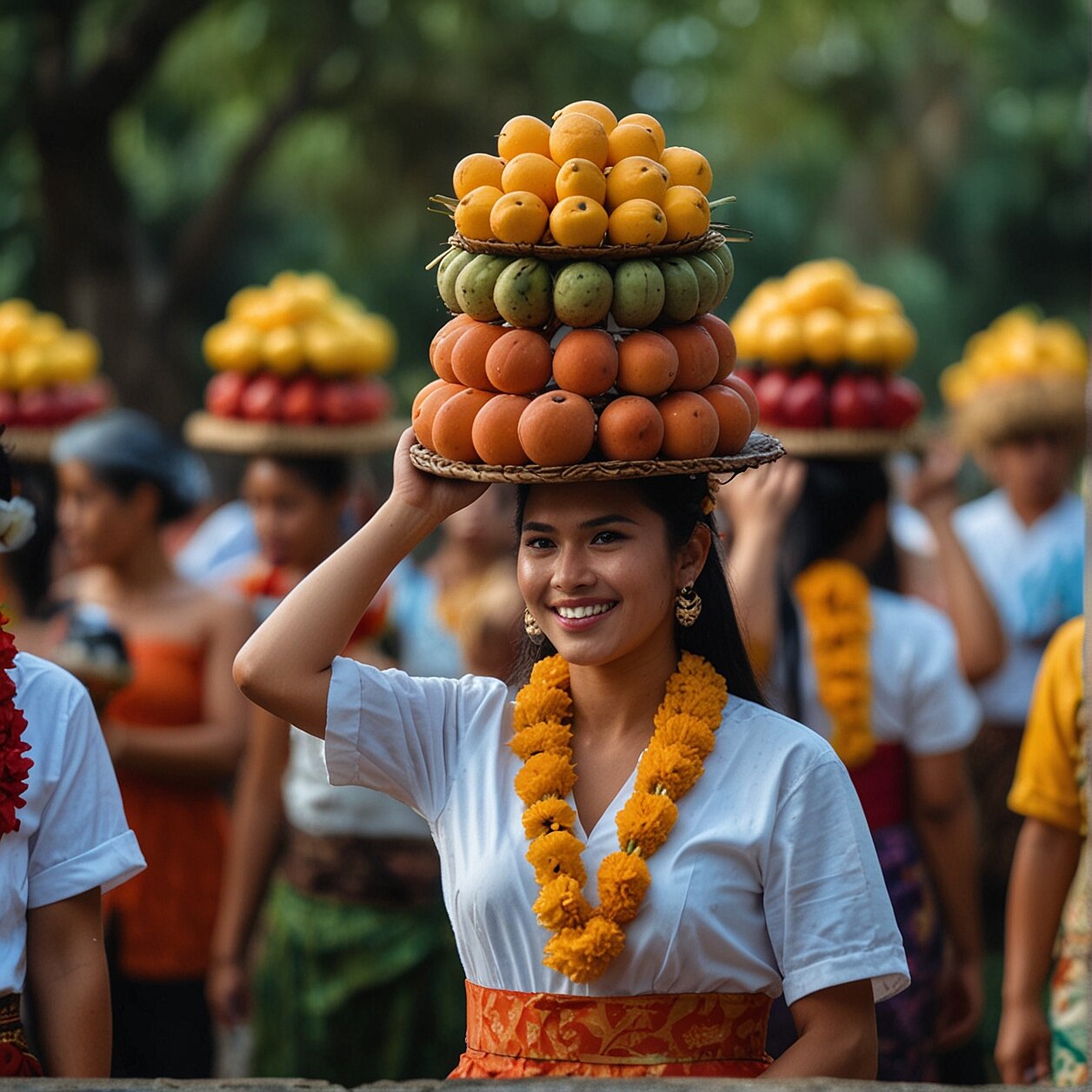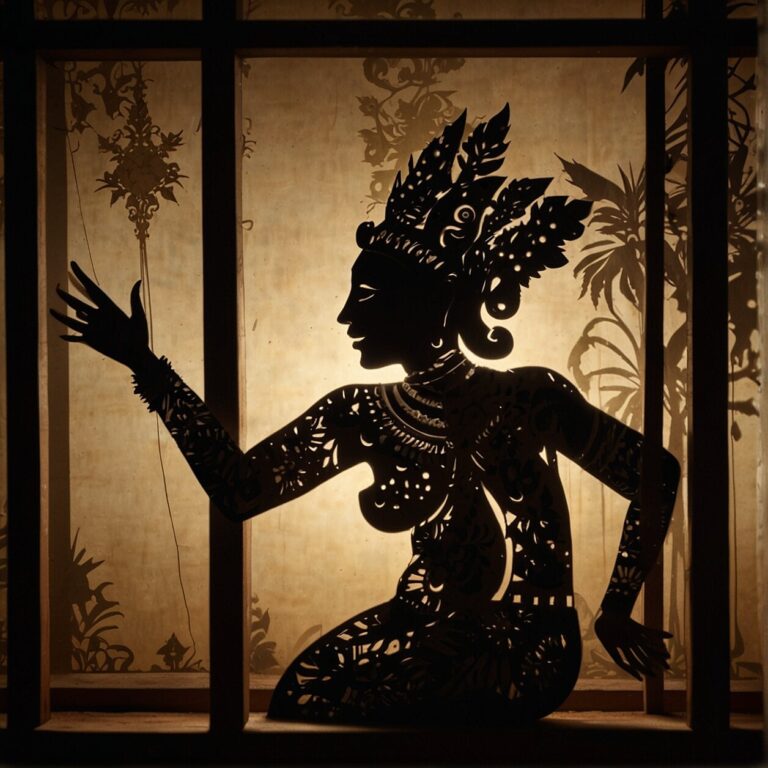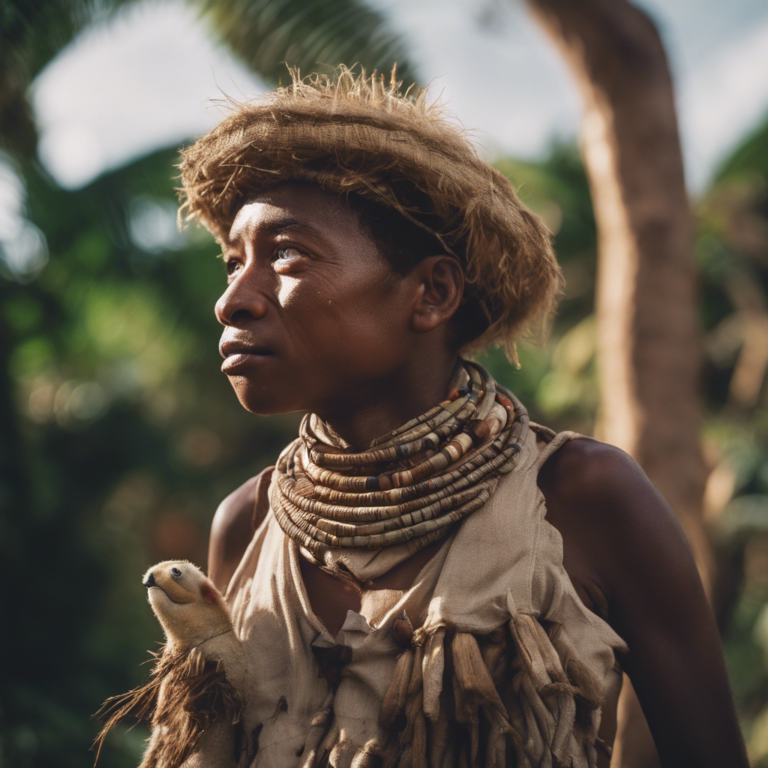A Local’s Guide to the Colorful and Vibrant Balinese Festivals – Exploring the Fun and Unusual Traditions
Bali, a paradise island dotted with pristine beaches, emerald rice terraces, and majestic temples, is known for more than just its physical beauty. It’s a culture-rich haven bursting with vibrant customs, age-old traditions, and a generous amount of festivals that color the daily life of its residents – festivals that are as charmingly diverse as the island’s landscape itself.
As someone who calls Bali home, let me take you on a journey to explore the most captivating, and sometimes, bewildering Balinese traditions – the festivals. They range from the sacred and spiritual to the extraordinarily unique and downright exciting. You’ll witness the island getting shut down completely on silent days, fantastic monsters parading the streets, majestic buffalo races, and so much more.
“The true beauty of Bali lies not in its gleaming beaches or looming volcanoes – it’s in the heart of the Balinese, reflected through their age-old customs and vibrant festivals.”
- Nyepi: when the island takes a day off to rejuvenate in complete silence.
- Galungan: that celebrates the victory of good over evil.
- Perang Pandan: where men duel with each other using thorny pandan leaves.
- Kuningan: a day for expressing gratitude to the ancestral spirits.
And these are just to name a few. Each Balinese festival has its unique story, its own significance, and a beauty that leaves any observer in sheer awe. So, are you ready to take a closer look and unearth what lies beneath the surface of all that noise, colors, and laughter? Strap in your seatbelts; this promises to be an exhilarating, enlightening ride!
Introduction: The Vibrant World of Balinese Festivals
Welcome reader to this enchanting dimension of Balinese culture – its vibrant festivals! As the saying goes, life in Bali is a constant festival. In this spellbinding island province of Indonesia, you’ll find the celebration of life and spirituality is not confined to specific occasions, but is intertwined into the fabric of everyday life. The festivals here, they are not just about pomp and show but they each have an undercurrent of spiritual depth, observed with fervor, echoing the ethos of a civilization.
If you’ve read our previous blog post on moving and relocating to Bali (which can be found here – Bali Guide),’ you’re aware how the island’s unique blend of vibrant culture, stunning landscapes, warm people, and spiritual traditions makes it more than just a beautiful vacation spot.
Each Balinese festival is a kaleidoscope of color, dance, music and, of course, the unique Balinese sense of the sacred. What makes these festivals even more special is that each has peculiar and interesting reasons and rituals behind their celebration.
In this article, we dive head-first into the myriad festivals in Bali, attempting to understand their spiritual, cultural, and social significance. From the most fun-filled to the strangest and everything in between, we’ve got a big list prepared for you.
Whether you’re a seasoned Bali goer, someone looking to relocate here, or just someone fascinated by Balinese culture, keep reading. This is going to be a fascinating and enlightening journey. Stay with us!
The Power of Rituals: Exploring the Sacred Ceremonies
As one deeply woven within the fabric of Balinese life, I tell you, it’s a remarkable sight to behold when ceremonies take center stage and immerse the whole of Bali in a captivating and vibrant spectacle. These traditional rituals, ingrained in our culture, are an essential part of Balinese society, serving an intricate blend of social and spiritual purposes. They are not just happenings, they are the soul of Bali.
Each of these festivals has its own unique flavor, manifesting through a symphony of incessant gamelan music, the aroma of incense, and the sight of beautifully dressed men, women, and children bearing offerings on their heads. But remember, dear reader, it’s much more than a visual and sensory treat; these festivals and rituals have deep spiritual significance and a profound purpose.
The Multifaceted Purposes of Rituals
At their core, most Balinese rituals come from a profound desire to maintain balance in the world, keeping in perfect harmony the cosmic forces that exist. The ceremonies, rich and filled with meaning, are primarily performed to appease and placate the various gods and ancestral spirits, seeking their blessings and favor to ensure peace and prosperity for the community.
These rituals also serve practical community purposes; they strengthen social bonds, define the rhythm of Balinese life, connect generations, and importantly, remind us of our cultural identity and responsibility towards our common shared heritage. In essence, they provide an incredible framework that allows us to process life events, marking passages, celebrating milestones and helping to heal during times of crisis or grief.
Touched by Divinity: The Role of Priests
The core of every ritual is the priest or Pemangku, who serves as the intermediary between the human and the divine realms. Clad in white with a distinctive headgear, the Pemangku conducts the ceremonies, chants mantras, and performs the rituals to invoke the deities. Without the Pemangku’s blessings, a ritual would not hold the same sanctity or importance. It’s the priest who breathes life into the ritual, making it a dynamic, living entity that touches every individual and resonates deep within us.
The Invigorating Energy of Rituals
With these rich layers of symbolism, ancient tradition, shared experience, and spiritual depth, the Balinese ceremonies are a source of powerful energy that charges the environment and invigorates our spirits. As we come together to participate, the joy, unity and dynamism created are tangible, reinforcing the fundamental values of respect, harmony, community and devotion that anchor the Balinese culture.
Each ritual has a story to tell, a slice of the grand tapestry of Balinese culture. Stick around, dear reader, as we take you through a journey of some of these fascinating ceremonies that define and color the cultural landscape of Bali.
Nyepi: The Silent Day that Shuts Down an Island
If you’re in Bali during late March, you might experience something quite unprecedented – an entire day where the island comes to a standstill. This day is called Nyepi, or the Day of Silence, and it’s one of the most significant festivals in the Balinese calendar. The island shuts down for 24 hours, providing a chance for self-reflection and repentance making it one of the most unique and introspective celebrations you might encounter while in Bali.
The day before Nyepi, a ritual called pengrupukan takes place. During this time, you’ll see the local community engaging in large processions as they parade massive ogoh-ogoh (demonic effigies) around the streets, making loud noises to drive away any lingering evil spirits. But as midnight strikes, the whole island plunges into a serene silence that lasts until the dawn of the next day.
During Nyepi, no light is allowed; households and streets remain dark. There’s no working, no travelling, and even the international airport closes down. It’s as if time has come to a standstill, where even the typically bustling streets are devoid of any activities. It’s a day devoted to complete silence, fasting, and meditation. The strict interpretation of ‘silence’ (Catur Brata Penyepian) means that no fires (and lights), no working, no travelling, and no indulging in amusements are allowed.
But why the silence, you ask? According to the Balinese people, this standstill is meant to trick evil spirits into thinking that the island has been abandoned. The uncontrollable, wild spirits will then leave Bali, providing a fresh and demon-free start to their New Year. Now, isn’t that a fascinating concept?
You may wonder what happens if you accidentally break the rules of silence, right? Well, traditional security men known as Pecalang patrol the streets during Nyepi, ensuring the rules are followed and peace is maintained. So it’s highly advisable to respect the norms and voluntarily participate in this day of self-reflection.
This Silent Day truly humbles you as it makes you realize the importance of introspection and self-restraint in our lives. It’s a day that allows you to reconnect with yourself, and is indeed a fresh and serene respite from our fast-paced, chaotic lives.
So if you’re planning your trip to Bali, make sure you’re aware of when Nyepi falls. Whether you decide to stay indoors and participate in the silence, or use it as an excuse to gaze at the unpolluted, star-laden night sky, Nyepi is a Balinese festival that shouldn’t be missed.
And yes, the entire airport is closed for 24 hours.
Galungan: Celebrating the Triumph of Good over Evil
Ah, Galungan. This is undeniably one of the most significant and cherished festivals in our Balinese calendar. Taking place every 210 days, Galungan is a ten-day celebration that gives life to our days and pervades our streets with blessings and joy.
What does Galungan commemorate, you may ask. This holy festival is all about acknowledging the triumph of Dharma (the essence of goodness) over Adharma (the force of evil). It reminds us to rebalance our lives, just as the universe seeks to maintain equilibrium. It’s a time for Indonesians to revitalize connections with their gods, ancestors, and eventually, their own souls. It’s a spiritual celebration intrinsic to the Balinese ethos.
The Meaningful Preparations
Preparation for Galungan starts long before the actual celebration day. You’ll witness as the Penjor, a tall bamboo pole, bend gracefully over the roads and houses. Draped in an array of fruits, uncooked rice, flowers, and palm leaves, these Penjors are not mere decorations. They’re symbols of prosperity and mark the triumph of good over evil. Onlookers can undoubtedly feel the vibrant energy they emit.
The Galungan Day
On the day of Galungan, the island buzzes with a frenetic pace. The air hums with the scent of incense, the sizzle of grilled suckling pig (known locally as ‘Babi Guling’), and the rustling of ceremonial clothes. Families head to temples to conduct prayers, and the air is alive with a vibrant energy. Drum-beats pair with enthralling Balinese music to form a placid background score to the day’s proceedings.
Manis Galungan: The Day of Relaxation
After the intense ceremonial day, we have Manis Galungan, the day to rest and rejuvenate. Locals visit their families, friends, and even take trips — all in the spirit of joy and thanksgiving. Much like a hangover cure after a grand party, Manis Galungan allows us to reflect upon the spiritual journey we undertook, while still bathing in the festive glow.
‘Makasih’, as we would say. This heartwarming word translates to ‘thank you’ and truly encapsulates the essence of Galungan. It’s about offering gratitude, acknowledging the lessons from the past, and instilling hope for the journey ahead. The Galungan festival truly is a testament to the Balinese spirit — resilient, hopeful, and forever in celebration.
Kuningan: Honoring Ancestors and Spirits
Enveloped in spirituality, the island of Bali marks the end of the Galungan holiday period with the festival of Kuningan, which literally translates to ‘Yellow’. As you meander down Bali’s streets, you’ll see homes and temples adorned with little yellow squares called ‘endongan’, made out of rice and colored with turmeric. Kuningan is an inviting spectacle of joyous celebrations and profound respect for the divine entities and ancestral spirits.
Days of Rituals and Offerings
The festival stretches over a period of 10 days, the last day being the most important. On this day, the Balinese make offerings for their ancestors. These offerings, made in a special box known as tamiang and endongan, symbolize protection and prosperity. With prayers and offerings, the Balinese show their gratitude towards their departed ancestors and spirits, send them back to heaven, and pray for their continued blessings.
The Socio-Cultural Significance
The significance of Kuningan has deep roots in the Balinese culture. It is a day to remember ancestors with warmth and respect. Many locals return to their family homes for the wrap-up of the 10-day festivities, which result in a wonderful reunion, making it a family affair to remember.
The Spiritual Connection
At the heart of it all, Kuningan brings about a spiritual connection that is deeply personal to Balinese Hindus. It embodies a moment of reflection, shared gratitude, and collective thankfulness for the prosperity and protection bestowed by their ancestors.
Experiencing Kuningan
If you find yourself in Bali during Kuningan, take this golden opportunity to observe and even participate in the events. You’ll glimpse beautiful penjor bamboo poles decking the streets, intricately patterned ‘cebongan’ offer baskets hanging outside homes, and processions of townsfolk in their gold and white best. Don’t shy away from joining the ceremonial observance, as it is truly a radiant display of Bali’s rich and thriving cultural and spiritual tradition.
To make the most of your Kuningan experience, respect the sanctity of the festival. Dress modestly, learn and obey the dos and don’ts, and always remember that you’re partaking in a deeply sacred ritual that means the world to the Balinese people. Kuningan is beyond just a celebration – it’s a slice of their life, their beliefs, and their heart.
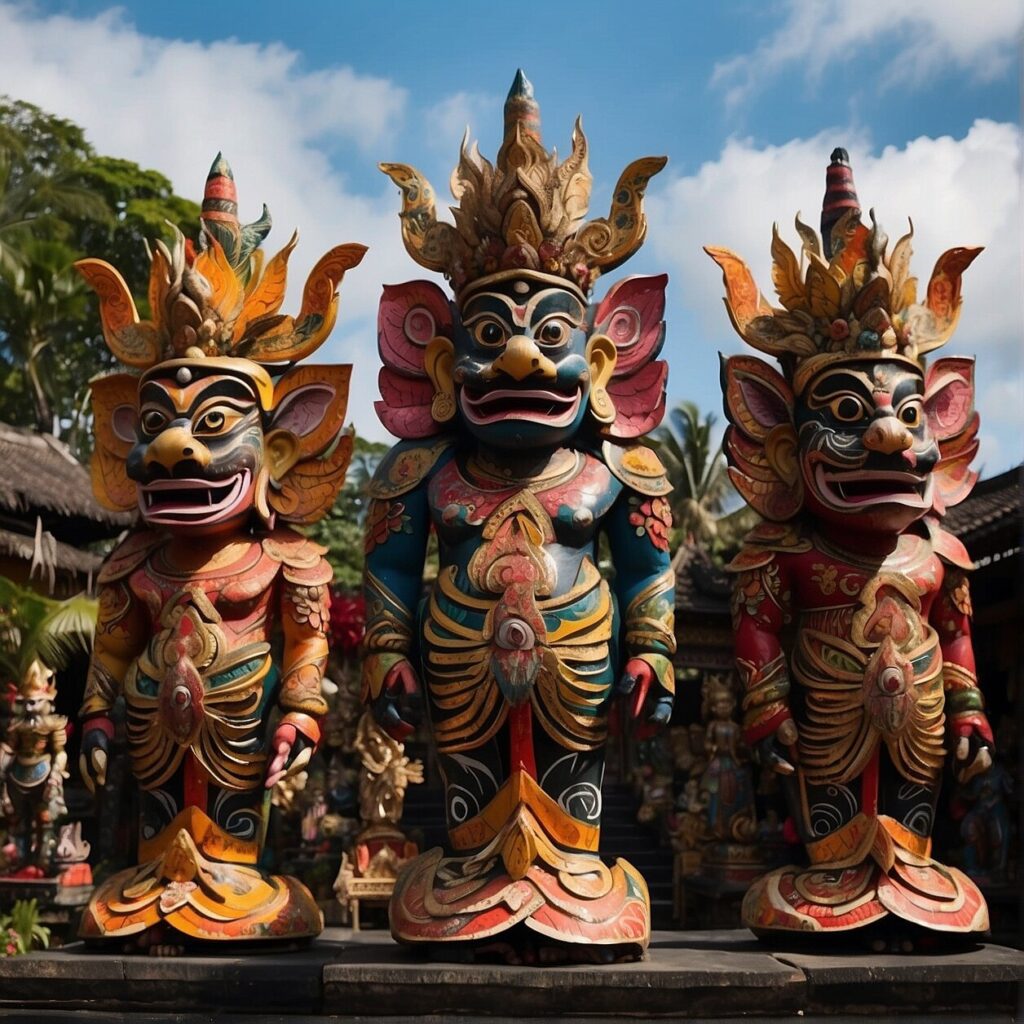
Ogoh-Ogoh: Unleashing the Fantastic Monsters
There’s an electric air that fills the atmosphere as we approach the Ogoh-Ogoh festival, a day that ignites the daring spirit of Bali’s residents and visitors alike. Unfamiliar with Ogoh-Ogoh? It’s one of the most visually spectacular and culturally significant events that the Balinese calendar has to offer.
The word ‘Ogoh-Ogoh’ refers to terrifying dolls that, with the creativity and dexterity of the island’s artisans, are brought to life. But these aren’t your everyday dolls. Ogoh-Ogoh are enormous papier-mache effigies, often reaching up to 5 meters in height, depicting mythological beings, demons, or spirits, also known as ‘Bhuta Kala’. Linked intricately to Balinese Hindu philosophy, these dolls are a tangible symbol of the spiritual and physical ‘dirt’ or ‘adharma’ that humans collect over time.
Don’t be fooled by the seemingly terrifying appearances of the Ogoh-Ogoh. Constructed with immense attention to detail, the effort and skill that goes into creating these enormous sculptures are something to marvel at. For weeks and sometimes months leading up to the festival, the tinkering sound of bamboo and the rustling of paper can be heard late into the night as communities come together to conceive these fantastic beasts!
Ogoh-Ogoh Procession
On the dusk of Pengerupukan, the eve of Nyepi, the island reverberates with an electrifying ambiance as communities gather to lift the colossal Ogoh-Ogoh onto bamboo grids. The streets of Bali come alive as the Ogoh-Ogoh are paraded around villages in a triumphant procession. They twist and turn the Ogoh-Ogoh in a stunning choreography, demonstrating the constant battle between good and evil. This entertaining spectacle is a delight for the eyes and is often accompanied by the dramatic tunes of the Balinese gamelan, making it one of the island’s most eccentric and unique festivals.
The purpose of this massive parade? It’s believed that the bright lights and deafening noise generated by parading the Ogoh-Ogoh confuses the evil spirits and forces them away from human settlements. This ceremony signifies the purification of the environment from these malevolent forces. And after the display, the Ogoh-Ogoh are symbolically burnt to ashes, symbolizing the eradication of negative elements and making way for a new year cleansed of evil. This ceremonial immolation is an integral part of the cultural tradition thereby stressing the cycle of rebirth and renewal.
In recent years, Ogoh-Ogoh parades increasingly attract international spectators, adding another vibrant dimension to Bali’s cultural magnetism. As someone living in Bali, I am continually astounded and inspired by the ingenuity, cultural richness, and spiritual significance of Ogoh-Ogoh. It showcases not only the artistic flair of the Balinese but, importantly, their enduring commitment to preserving and celebrating their unique heritage.
Tawur Kesanga: The Bloody Battle against Evil
The day before the silence of Nyepi descends upon Bali is marked by a unique ceremony known as Tawur Kesanga, or the Bloody Battle against Evil. This traditional Balinese festival, deeply steeped in the island’s mytho-religious folklore, aims to appease malicious spirit entities and purify the environment as the Saka New Year rolls in.
The significance of Tawur Kesanga in the belief springs from the cyclic conflict between good and evil inherent in the Balinese cosmology. This confrontation is not stylized as a simple fight, but rather as an intense struggle, represented by fearless warriors and beasts depicted in colorful effigies.
The Ritualistic Unfolding of Tawur Kesanga
The day starts at the crack of dawn with a group of village warriors, or “Pecalang,” patrolling the area, ensuring the rigid observation of the ritualistic procedures. Simultaneously, community members create colorful Rangda and Barong figures—symbolic incarnations of evil and good—and place them at the crossroads, squares, or strategic points in the village. These represent the spirit embodiments of negativity that are being expelled out of the community before the New Year.
As the day progresses, the villagers conduct a series of prayers and offerings. Priests chant mantras and present offerings called ‘banten tegeh,’ composed of food, flowers, and other organic materials, at these effigies. The aim is to lure the negative forces into these effigies, trapping them to be expelled afterwards.
As the sun sets, the climax of Tawur Kesanga unfurls. Villagers form a procession, carrying the effigies and converging at a central location – usually by the sea or a river. Spiritual leaders conduct a final puja, driving the enclosed evil spirits away, symbolically purifying the community.
The ultimate act is a symbolic bloody battle. Villagers use their homemade ‘keris’—a type of dagger—to stab at the effigies, mimicking a fight with the evil spirits. This cathartic act of violence is aimed at freeing the community from evil influences and is accompanied by fiery torches, loud noise, and fervent chanting.
With the spirits expelled, the burning of the effigies follows, symbolizing the annihilation of evil. The resulting ashes are then dispersed in the sea or river, signifying the neutralization and purification of all malicious forces.
After these intense and vibrant rituals, Bali plunges into complete silence with the arrival of Nyepi – a stark shift that symbolizes the fresh start granted by the victory over evil energies embodied in the Tawur Kesanga.
Saraswati: The Day of Knowledge and Wisdom
Imagine a sea of white-clad people with books, scrolls, and even laptops in hand, praying to a goddess. A day where everyone, children and adults alike, brings their most cherished equipment of learning to be blessed. Few cultures elevate the act of learning to the realm of divine as vivaciously as the Balinese during the Saraswati day. Saraswati, known as the goddess of knowledge, music, art, wisdom, and learning, is celebrated every 210 days on a Saturday in a grand ceremony throughout Bali. This day is a testament to the people of Bali – no matter how modern the world becomes, ancient wisdom never loses its sheen.
Embracing Knowledge: Morning Rituals
The celebration starts early in the morning at every home and school. People present offerings in front of handcrafted bamboo alters filled with books and scrolls, which represent knowledge. You’ll even see the modern touch of offerings placed in front of computers and laptops. These rituals serve the purpose of thanking the divine for wisdom and knowledge imparted.
Festivities and Symbols: Coloring the Day
As the day carries on, streets come alive with processions and the celebratory sound of gamelan music. Schools and universities organize events where students perform traditional dances, dramas, and recite old scripts, putting the wisdom they’ve accrued into practice.
An Artistic Feast: The Evening Saraswati
When day turns into twilight, it’s time for Balinese artistry to take the stage. You’ll be in awe of the performances — of music, dance, theater, and shadow puppets — offering an enchanting spectacle. These performances encapsulate Balinese culture in dramatic and colorful displays. The evening festivity is a festive celebration of the island’s artistic heritage, fueled by the wisdom and learning the islanders revere.
A day dedicated to knowledge and wisdom, Saraswati becomes a symbol of Bali’s respect and reverence for learning, and demonstrates that the pursuit of wisdom is an integral part of human life.
Pagerwesi: Strengthening the Spiritual Armor
Next on our captivating journey through Balinese culture and spirituality is Pagerwesi, a celebration and ceremony held every 210 days. Rich in spiritual depth, the Pagerwesi Festival carries a unique resonance for the local community.
The name ‘Pagerwesi’ originates from two Javanese words: “Pager” which means fence, and “Wesi” which means Iron. This can be symbolically referred to as ‘iron fence’. The philosophy behind this name revolves around an important life principle: spiritual strength. It’s a day when the Balinese spiritually ‘fence’ themselves with values and virtues to resist evil forces.
Embracing the Protective Shield
One of the most distinctive aspects of the Pagerwesi festival is its emphasis on spiritual protection. This day is meant for personal introspection and self-reflection, during which individuals fortify their minds and souls against negativity and harmful influences. With mindful prayers, offerings, and rituals, the Balinese seek to strengthen their spiritual ‘armor’ – their internal defenses against real and metaphysical threats.
This is accomplished in various ways, one of which is through conducting elaborate rituals at their family shrines. These rituals involve the making of beautiful offerings, their presentation to the gods, and the recitation of mantras. Every member of the family, regardless of age, takes part in the rituals, each contributing in their own unique ways.
A Physical Transformation Aligning With the Spiritual One
Unsurprisingly, the island undergoes a remarkable transformation on Pagerwesi. Homes, streets, and temples are adorned with elaborate decorations, usually made of coconut leaves, flowers, fruits, and traditional cakes. These serve as offerings to the deities and ancestors, tangible signs of respect and devotion asking for protection and guidance. It’s a sight to behold: the humble beauty of Balinese ornamentation perfectly embodying the balance of aesthetics and spirituality that makes this island so fascinating.
But Pagerwesi is not just about flashy decorations or grand ceremonies. It’s a day of contemplation, a reminder of the importance of wisdom in dealing with life’s challenges. As tourists, the philosophy behind this unique festival can serve as an enriching lesson. As we immerse ourselves in Balinese culture, its elegance allows us to reflect on our own lives and encourages us to prioritize spiritual strength over anything else.
So next time you happen to be in Bali during Pagerwesi, be sure to take this opportunity to dive deeper into the island’s spiritual essence. Embrace the protective shield of values and virtues, and see how this blessing enhances your journey on the Island of the Gods.
Melasti: Purifying the Soul by the Ocean
Imagine a beautifully choreographed dance of faith, a procession of thousands in resplendent attire, all headed towards the sea. This is Melasti, a significant religious ceremony in Bali that is held a few days before Nyepi, also known as the Day of Silence.
The Spiritual Significance
In the Balinese philosophy, Melasti stands as a symbolic purifying ritual. It is a moment to cleanse one’s body and soul, to rid oneself of the impurities of the past, and prepare for a new beginning. Beyond simple purification, Melasti symbolizes the resetting of the spiritual and physical realms.
Chasing the Impurities
Every year, devoted Balinese Hindus carry the ceremonial ‘prasasti’, religious artefacts, from their respective temples, in a majestic procession towards the ocean or any other significant body of water. The ocean, in Balinese Hinduism, is considered to be the source of sacred water. It’s believed that these primeval waters possess the power to wash away impurities and bring about purification.
The Coastal Confluence
Communities from different villages come together along the coasts of Bali, creating a sea of white clothing against the blue backdrop of the ocean. The intricate details of their traditional attire are sure to leave you astonished, adding to the unique spectacle that is Melasti.
The Ceremony: A Celebration of Harmony
The holy priests lead the ceremony, with prayers being chanted, offerings being served to the Ocean God, and the ‘prasasti’ being immersed in the ocean water. Melasti incorporates the elements of Earth, Fire, Water, Air, and Space to symbolize the fundamental principle of Tri Hita Karana – the harmonious relationship between humans, God and nature. It’s an emblematic discipline where the microcosm that is humanity interacts with the macrocosm that is the universe.
A Feast for your Senses
The atmosphere during the Melasti procession is electric – filled with spiritual energy, the aroma of incense, the sounds of the gamelan orchestra, and the sight of elegant forms of Balinese dance. It is a sensory feast, offering a tantalizing glimpse into the depth and sincerity of Balinese spiritual practices.
Oftentimes, once the ceremony concludes, the communities spend the remainder of the day together, forming a large, vibrant social gathering on the beach. The adults converse and celebrate, while children play and enjoy the beach. It’s a gorgeous display of the Balinese sense of community and spiritual harmony.
Witnessing Melasti
If you find yourself in Bali around the time of Melasti, do not miss the opportunity to witness this grand spectacle. Remember to be respectful of the rituals and if possible, participate alongside the local community. It’s a chance to not only observe but also understand the profound spiritual depth and cultural richness of Balinese Hinduism.
Pengerupukan: Warding off Evil Spirits with Ogoh-Ogoh
As the sun sets on the eve of Nyepi, Bali springs to life with the bustling excitement of Pengerupukan. Unlike Nyepi, which is characterized by silence, Pengerupukan is a boisterous affair, filled with the cacophonous sounds of gongs, drums, and gamelan orchestras.
This spectacular festival serves a singular profound purpose: to ward off evil spirits. How, you ask? By the thunderous display of the bizarre and haunting Ogoh-Ogoh—towering effigies resembling creatures from the underworld.
The Making of the Ogoh-Ogoh
For weeks before Pengerupukan, local communities work collectively to create the monstrous effigies of the Ogoh-Ogoh. The technical correctness of these sculptures, their details, robustness, and symbolism, are a matter of local pride. The colossal artworks, some towering above 25 feet, are painstakingly crafted from light materials like bamboo and paper—ephemeral materials for what’s essentially an ephemeral existence.
The Roar of the Parade
As evening descends, the darkness is pierced by the eerie glow emanating from the Ogoh-Ogoh. The effigies are strapped onto bamboo grids and carried through the streets in a grand procession. The bearers sway the Ogoh-Ogoh from side to side—a symbolic act of stirring up the evil spirits. Emulating the capricious energy of these spirits, the procession takes a zig-zag route instead of a straight line. The air is heavy with drama as the entire island reverberates with the clanging sounds, signifying the unruly chaos of the netherworld.
The Climax: Ngrupuk Ritual
The climax of Pengerupukan is known as the Ngrupuk ritual, where these monstrous embodiments of evil and malice are musically and theatrically brought to life. Pyrotechnics add to the vibrant spectacle that reaches a fever pitch in a battle scene where mythical characters fight against malevolent spirits—a touch of the theatrical illuminating ancient folklore.
The Purging of Evil
The evening’s culmination comes with the cultural belief that evil spirits have been coaxed into the vulnerable mortal world, only to be triumphantly trapped within the Ogoh-Ogoh. In a dramatic presentation encapsulating the eternal war between good and evil, these effigies, aka the captured malevolent spirits, are set ablaze in a public spectacle. The flames crackle with the promise of victory, purging evil from the island and symbolizing a clean slate for the upcoming year.
Experiencing Pengerupukan is to witness a world left unseen, a world peppered with rich symbolism, community unity, and a powerful belief system. It beautifully encapsulates the Balinese perception of the eternal cycle of birth, death, and rebirth. As a traveler, you walk away with more than just memories—you journey back with a chunk of Balinese cosmology.
Tumpek Landep: Blessing the Metal Objects
The island of Bali resonates with a mystical aura, ingrained largely by its innumerable traditional customs and rituals. One such fascinating and unique festival is Tumpek Landep which venerates the divine believed to reside in metal objects
Tumpek Uduh: Blessing the Plants and Nature
If you’re fortunate enough to be in Bali for Tumpek Uduh, you’re in for a treat, a sort of Balinese Arbor Day, where blessings are showered upon the kingdom of plants. There is a profound appreciation for nature’s bounty in Balinese tradition, and this vibrant event shines a spotlight on it.
Tumpek Uduh, sometimes referred to as Tumpek Wariga or Tumpek Pengatag, takes place every 210 days, aligning with the Balinese Pawukon calendar. This is a day dedicated to Sanghyang Sangkara, the God of All Food Providers, paying homage to the great gifts bestowed by Mother Earth.
During the festival, the community comes together to craft intricate offerings, known as banten, and place them at the foot of trees, shrubs, and even at the local markets selling fruits and vegetables.
Embracing Mother Nature
These offerings, typically comprising food items, fruits, traditional cakes, and other edibles, placed in containers made of a specific type of leaf called janur, are not random. Every aspect of it signifies an aspect of nature and agriculture. Some offerings might include rice, symbolizing prosperity, while others may feature a certain type of fruit, each representing different aspects of nature’s abundance. For instance, bananas symbolize fertility while oranges represent a successful harvest.
Every member of the community, including farmers, market sellers, and household members, participate in this ritual. It’s a time when everyone offers their respects and shows gratitude towards the natural world. But, it’s not limited to cultivated plants; every plant is identified and appreciated for its contribution, from the practical rice plant to the ceremonially sacred banyan tree.
The Blessings
Once the offerings are in place, prayers are conducted, blessing all elements of nature that contribute to human well-being. Priests and religious leaders arrive to lead the congregation, sprinkling holy water, and extending chants of ancient scripts, enunciating their gratitude to Mother Nature.
The day is rich with a sense of gratitude and respect for the environment. This deeply ingrained sense of reverence for nature compels locals to ensure the sustainable use of all natural resources.
The basic philosophy underlying Tumpek Uduh is a beautiful reminder of the significance of the environment in daily life. It cherishes the critical role that flora plays in Balinese culture, including the part it plays in ceremonies, festivals, and essential daily rituals. It’s a testament to how deeply environmental appreciation is woven into the Balinese way of life.
Tumpek Wayang: Paying Tribute to the Puppetry Arts
The island of Bali thrums with a unique rhythm, as every aspect of life, from the mundane to the extraordinary, is celebrated through a myriad of festivals. One of these remarkable ceremonies is Tumpek Wayang, an event dedicated to honoring the ancient art of puppetry.
Tumpek Wayang is a day when the Balinese pay their respects to Sang Hyang Iswara, the god associated with the sun and the moon. Sang Hyang Iswara is believed to be the creator of the stunning shadow puppets used in the traditional Balinese puppet shows known as wayang kulit.
The Celebration of the Puppetry Art
The festival is a tribute to the enchanting narratives spun through wayang, or puppet masters, and their crafted shadow puppets. Traditional plays often depict scenes from the Ramayana and Mahabharata, the two great Indian epic stories that have spread across many Asian cultures, including that of Bali.
The day starts with the Balinese carefully cleaning and sprucing up their puppets, making them look as good as new. These puppets are then dressed in the finest of clothing and presented with a range of offerings – everything from fragrant flowers and incense to mouth-watering Balinese delicacies. A meticulous ritual is performed with families paying homage to the puppets, recognizing their significance as conduits for conveying cultural wisdom and divine teachings.
The Puppet Master
The role of a puppet master, or dalang, in Balinese culture, is highly significant. Considered much more than mere storytellers, the dalang is seen as a scholar, spiritual interpreter, and a teacher. They devise elaborate narratives and perform ‘shadow play’ using puppets behind a lantern-lit white screen. The shadows cast through the puppets on the screen tell captivating tales, explaining morality, spirituality, and cultural beliefs.
On Tumpek Wayang, a dalang is often invited to perform with his puppet troupe at the Balinese homes. This performance is seen as not just entertainment, but a sacred ritual inviting protection and divine blessings into homes. The artistry and skill demonstrated during these performances are seen as offerings to the divine, a symphony of shadows, and light, bringing the mythic tales to life.
In sum, Tumpek Wayang isn’t just a day to celebrate the puppets but also a tribute to ageing tradition and skilled puppet masters who keep the flames of this ancient art form alive.
Piodalan: Celebrating the Temple Anniversaries
When it comes to holding an intriguing and spiritual showcase of belief, Balinese people hold nothing back. Nowhere is this more apparent than in the Piodalan – the anniversaries of temples, a celebration that not only honors the temple’s journey but the gods associated with it.
The Piodalan takes place every 210 days – in accordance with the Pawukon, the Balinese calendar of religious occasions – and signifies another year of the temple’s existence and its deity.
Pre-Celebration Preparations
Days before the temple anniversary, the whole community begins preparations. Everyone participates in decorating the temple using Pengalungan decorations made from a special kind of bamboo filled with beautiful flowers and green coconut leaves. And while the temple undergoes a striking ornamental transformation, the air buzzes with the aroma of incense sticks and the energetic chatter of temple-goers.
The Grand Processions
On the day itself, a grand procession sets the energetic tone of the festivities. Offerings are prepared, each participant conscientiously crafting an array of colorful, intricate, and spiritual gifts for the deity. These can include cultural artifacts, holy symbols, fruits, and even small animals. The path towards the temple gets adorned with beautifully woven palm-leaf arches – providing a divine canopy for the procession. Each step taken under this canopy amplifies the bond between man and deity, while serving as a testament to the community’s reverence and festivity.
The Aromatic Ceremonies
Once inside the temple premises, ceremonies begin in earnest. The air fills with sacred chants and prayers offered to the gods, and the smell of burning incense sticks swirls aromatically throughout the precincts. Men and women from the community, dressed in traditional attire, come forward in turns to place their offerings before the god, recite prayers, and partake in the communal feast. The whole process is uplifting and enlightening, a testament to the vibrant and profound Balinese spirituality.
Performances and Gatherings
The celebration doesn’t end there though; after the prayers, performances take center stage, featuring traditional Balinese dances or plays based on Hindu mythology. These spectacles captivate locals and visitors alike, beautifully concluding the celebration. The evening wraps up with a gathering of the community, a culmination of harmony, solidarity, and shared culture, a tremendous testament to the spirit of Piodalan.
From sacred ceremonies to festive gatherings, Piodalan serves as a fascinating reminder of the cultural richness and spiritual depth of Bali. These temple anniversaries aptly reflect how the island and its community continually embody tradition, unity, and a deep respect for the divine, thus adding yet another feather to the heavy ‘festival cap’ of Bali.
Odalan: Honoring the Deities of the Village
Stepping into the realm of Odalan, let’s explore one of the most integral ceremonies of Balinese culture. If you’ve ever heard of the term ‘Balinese birthday for temples’, this is it. Odalan is not just an occasion; it’s a heartfelt homage to the village deities wherein communities come together in celebration, prayer, and reverence.
Communing with the Divine
Odalan festivals are sacred commemorations of the foundation of the village temples. These occur every 210 days – based on the unique Balinese calendar – and last for one day to up to an entire week. During this time, villagers cleanse and decorate their temples with beautiful offerings to honor the deities. The air resonates with the intoxicating aroma of incense, intertwining with the melodious chants from the priests.
A Kaleidoscope of Symbols
The festivities are imbued with a mystical blend of art and spirituality. Strong faith, vibrant colors, and the symphony of gamelan music make every ceremony an unforgettable experience. Whether it’s the profound silence of Nyepi, the pageantry of Galungan, or the exuberance of Ogoh-Ogoh parades, Balinese festivals are an essential part of island life. They carry forward ancient traditions, remind us of universal truths, bring communities closer, and transform the mundane into the sacred. Join me as I unveil the beauty, depth, and uniqueness of these celebrations.
Rambu Solo: The Elaborate Funeral Ceremonies
One of the most significant ceremonies on the island of Bali is the Rambu Solo, an elaborate and deeply emotional event that marks the journey of a person’s spirit towards the afterlife. This is an observance embraced with solemnity and seriousness, intertwined with elements of festivity and community bonding.
Rituals of Return
The Rambu Solo, or Balinese Funeral Ceremony, can be described as a “ritual of return”, where the individual’s journey to the afterlife is aided by detailed rituals designed to unify the body, soul, and cosmos. It’s believed that without this essential ceremony, the soul of the deceased will roam aimlessly, causing imbalance and discord in the living world.
A Feat of Community and Family
Given the massive scale of preparations needed, Rambu Solo is not just an individual or family affair. Instead, it becomes a community event – with friends, neighbors, and sometimes even strangers pitching in to help with the process. From crafting the extravagant bamboo tower and the effigy of the departed, to preparing meals for the attendees, this colossal effort truly reflects the spirit of gotong royong (mutual help).
The Elements of the Ritual
The Rambu Solo ceremony is adorned with various essential elements. One striking aspect is the use of a wadah—an opulently decorated bamboo tower transporting the body of the deceased in a procession through the village. A buffalo is often sacrificed and its meat shared among the community, symbolizing the transportation of the soul to the upper world. The highlight of the ceremony is the cremation, symbolizing the liberation of the soul. Post-cremation, the ashes are collected and later dispersed into the sea, marking a poignant moment of final farewell.
Symbolic Significance
The ceremony embodies a deep respect for the cycle of life and death, underscoring the Balinese belief system that pays equal regard to the seen (sekala) and unseen (niskala) aspects of life. It joyfully celebrates the passing into a new spiritual realm, rather than mourning the end of corporeal existence.
Despite its solemn nature, there’s something profoundly touching about a Rambu Solo. It’s not just a funeral— it is a profound testament to the Balinese community’s spirit, their belief in the afterlife, and the enduring love they carry for those who have passed on.
Makepung: The Thrilling Buffalo Races
You’ve probably heard of horse racing and camel racing but on the island of Bali, we host a rather unique kind of race—the buffalo race, known as Makepung. Straight out of the district of Jembrana, in the West Bali, Makepung draws thousands of tourists from around the world while painting a unique sketch of Balinese local culture and tradition.
Spanning over a period of several weeks, Makepung is far from being just a one-day affair. It builds up to a grand finale in the form of the Governor’s Cup (Piala Bupati).
Origin and Signifance
The buffalo races of Makepung find their roots in the mundane activity of ploughing the fields—an essential part of Jembrana’s farming routine. The buffalo owned by farmers were viewed as an extension of the family and not just limited to being beasts of burden. These buffalo races started off as friendly competition between farmers while also doubling as a form of entertainment during breaks.
The Race Day
On the race day, hundreds of pairs of buffaloes, fondly referred to as Kerbau Pepadu, are colorfully adorned in traditional Balinese cloth, ribbons, and bells. The spectacle simply is a feast for the eyes. The men, wearing their traditional udeng headwear and batik shirts, guide their buffaloes along a course of about 2 kilometers.
A Blend of Courage and Skill
Makepung is as much about the skill and bravery of the rider, who is known as Joki, as it is about the buffalo. These races can reach speeds of up to 60 km per hour, and it’s the Joki’s responsibility to keep the buffalo in line, avoiding any mishaps while completing the course in the fastest time possible.
Each season of Makepung concludes with a grand final race that features hundreds of participating buffaloes and jockeys. The topmost honours are not just limited to winning the race. A panel of judges also awards prizes for the best dressed buffaloes, adding another layer of excitement to the event.
Experience the Excitement
To truly immerse yourself in the colors and vibrancy of Makepung, plan to stay in Negara town, which provides the best access to the race tracks. Often accompanied by Gamelan Beleganjur (a traditional symphony of Balinese instruments), the whole atmosphere turns electric with the thrill of the races and cheers from the crowd.
So if you find yourself in Bali around the time of Makepung, make sure to include the thrilling buffalo races in your itinerary. It’s not just about witnessing an exotic race, but also about participating in the rhythmic dance of Balinese life and culture.
Usaba Kedasa: The Sacred Month-Long Rituals
We have journeyed through the fabric of Bali’s vibrant rituals and it has brought us to one of the island’s most sacred celebrations – Usaba Kedasa. This elemental festival is a month-long ritual unique to the village of Pedawa in the northern part of Bali. Scaled over a lunar calendar month, it is a wonderland of rituals steeped deep in the extraordinary balance that is Balinese life. Let me walk you through the captivating motions of this month-long ceremony.
The Bountiful Beginnings
The festival commences with the stroke of a gong, heralding the ‘nunas tirta’, or the sacred search for holy water. A core element in Balinese rituals, the water is obtained from eleven different sources, each symbolic of a different force of life. This task falls on dedicated priests, aided by a committed contingent from the village. The procession, set against the serene Balinese backdrop, is a sight to behold.
Dewa Masraman – The Historic War
Usaba Kedasa features a myriad of rituals, out of which the reenactment of the legendary Dewa Masraman war puts forth a dramatic spectacle. Villagers divide themselves into two groups representing the rivaling kingdoms, adorned in traditional attire and armed with bamboo sticks acting as spears. It’s a display that paints a vivid picture of Balinese history, making the past come alive.
Rituals in Repetition
Most of these striking rituals are repeated eleven times throughout the month, with the number eleven holding special significance in this festival. Usaba Kedasa is a magnificent spiral of traditional music, intricate dances, and offerings to keep bad energies at bay and promote prosperity for the community. It’s like watching a dream unfurl before your eyes.
A Show of Solidarity
One can’t overlook the display of unity and community strength in Usaba Kedasa. The breaking of bread, shared laughter, and mutual respect are a testament to the communal harmony that is ingrained in Balinese society. The festival is not just an enactment of rituals, but a learning experience in community living and harmony.
In conclusion, Usaba Kedasa isn’t merely a festival; it’s a life lesson of balance and unity packed within an assortment of rituals. Each day of the month holds a new surprise, making the entire celebration an all-encompassing journey. A manifestation of Bali’s diverse and charming practices, it truly captures the island’s soulful essence.
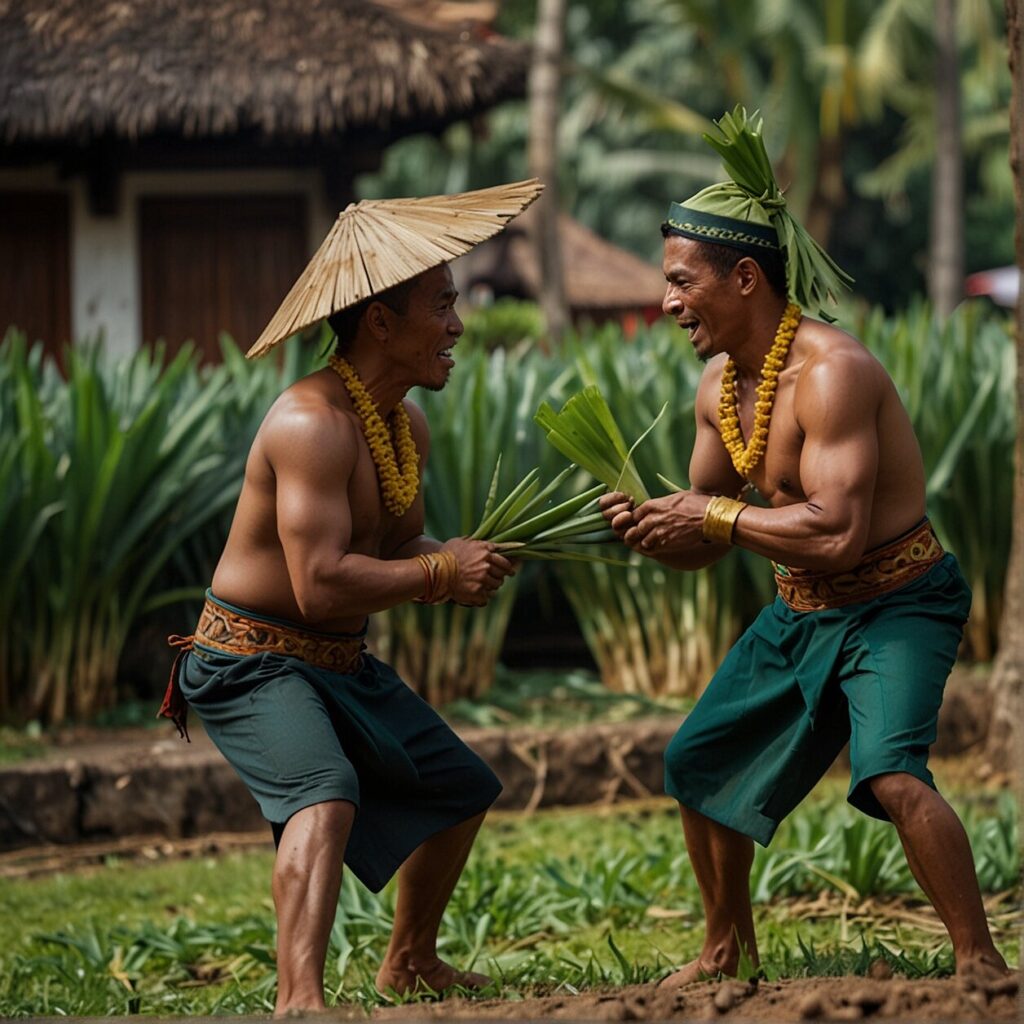
The Odd and Unusual: Uncovering Unique Festivals
As an island known for its vibrant culture and year-round festivals, Bali presents a rich tapestry of events that range from the deeply spiritual to the wonderfully eccentric. Let’s delve into some of the more unique, lesser-known Balinese festivals that you may not have heard of but offer a gripping glimpse into the local traditions and cultural ethos.
Mekare-kare: The Pandan Leaf War
Perhaps one of the quirkiest festivals in Bali is the Mekare-kare or also known as Perang Pandan. This involves men from the village of Tenganan challenging each other in friendly duels using pandanus, a tree-like plant with sharp, sword-like leaves. Clad in traditional sarongs and shields made of woven rattan, the warriors take turns to strike each other amid the roaring cheers of spectators.
Omed-Omedan: The Kissing Ritual
Another offbeat but a lively celebration is the “Omed-Omedan” or the Kissing Ritual, known to induce giggles among onlookers and blushes among participants. Held in Banjar Kaja Sesetan Village, this festival involves pairs of unwed youths engaging in friendly ‘kissing battles’ to supposedly ward off bad luck. This event embodies the Balinese belief of maintaining a balance between all elements, in this case, the playful energy of youth.
Nyakan Diwang: The Fire Walking Ritual
Next comes the ‘Nyakan Diwang’ or the Fire Walking Ritual, an awe-striking tradition that dates back to ancient Bali. During this ritual, villagers believe that they become invulnerable by the power of their faith and the blessings of the priests. Watch as villagers – in a show of spiritual fortitude – walk barefoot on smoldering embers, leaving spectators agape.
The Tawur Agung Kesanga
Another unique festival is the ‘Tawur Agung Kesanga,’ marked by a procession that leads to the beach, where effigies symbolizing evil forces are burned in a grand bonfire. This ritual signifies releasing negative energies back into the universe and is predominantly witnessed on beaches around Bali. Participation induces a sense of connection with the universal struggle against evil.
No matter how unusual they may seem at first glance, these distinctive festivals carry deep meaning for locals. They are a testament to Bali’s multifaceted culture and the harmonious coexistence of its inhabitants with nature and mythology. They’re not just entertaining to watch but also compelling to understand, offering rich insights into the many layers of Balinese spirituality.
Soaked in Colors: The Mesmerizing Kite Festivals
The summer breeze in Bali is synonymous with vibrant hues splashed across the open blue skies, all thanks to the stunning spectacle of the Kite Festivals. Yes, you heard it right! Kites aren’t just pastimes for kids on the island; they become part of a grand spectacle, a cultural experience that unfolds during the dry season, bringing the community together and linking them to their spiritual beliefs.
The Kite Season
From June to August, the skies of Bali undergo a colorful transformation. Farmers bless the skies with their traditional kites as a gesture of gratitude for a fruitful harvest season. This personal ritual eventually turned into a massive festival, bonding communities and honoring local gods to beckon in favorable winds for the season.
The Artistic Marvels
The ornate designs of these kites are more than just stunning displays of craftsmanship; they’re a testament to Bali’s rich heritage. The most popular kites are in the shape of a Bebean (fish), Janggan (bird), and Pecukan (leaf). Each of these carries profound meanings and symbolizes certain aspects of life and nature. The color patterns and designs are thoughtfully created, often depicting mythological themes or inspired by local flora and fauna.
The Community Spirit
Kite-making is a communal endeavor, with young and old coming together to build these aerial marvels. Kite-making competitions are a common sight, adding more flair to the festive environment. It’s not just about flying the most colorful or the biggest kite; it’s a demonstration of ingenuity, craftsmanship, and team spirit.
Catching the Wind
On the day of the festival, the euphoria on the ground matches the excitement in the sky. As the vibrantly colored giants dance and swoop in the air, spectators look on in awe, cheering for their community’s kite. This high-spirited competition brings an infectious energy that engrosses everyone present. It’s not just about winning but also about partaking in the fun and relishing the collective enjoyment.
Witnessing the Splendor
If you’re visiting Bali during the kite season, make sure to experience this astonishing festival. The Sanur Village Festival and the Bali Kite Festival in Padang Galak beach are among the main events, promising spectators a cultural spectacle that’s high on energy, tradition, and visual appeal. Take a step back from the bustling tourist spots and immerse yourself in a truly authentic Balinese tradition.
Conclusion: A Year-Round Celebration of Balinese Culture
To conclude, it is profoundly evident that Balinese culture is a vibrant tapestry woven with a myriad of incredibly unique, enchanting, and sometimes, slightly unusual festivals. Each Balinese day, week, and month is imbued with remarkable celebrations that extend beyond mere entertainment or merrymaking.
Balinese festivals uphold spirituality, ancestral respect, divine remembrance, knowledge, wisdom, and a massive dose of fun, infused in the form of puppetry arts, exhilarating buffalo races, and vibrant kite festivals. Rituals such as Melasti revitalize individuals by chasing away impurities and aligning souls with nature, while others like Pagerwesi strengthen spiritual armor and protection.
Rituals often unfold with a harmonious rhythm that speaks volumes about quintessential Balinese philosophy of “Rwa Bhineda” – the harmony of opposites. Priests, as intermediaries between humans and the divine, play a pivotal role in transforming mundane reality into the sacred, with every ritual carrying multifaceted purposes that bolster the spiritual, social, and environmental fabric of the island.
Festivals like Galungan and Kuningan resonate with universal themes of good triumphing over evil, while uniquely Balinese celebrations like Ogoh-Ogoh and Tawur Kesanga bring to life fantastical monsters and bloody battles against evil, signifying the inevitable flux of realities painted in hues of good and evil.
Some, like Mekare-kare, give warriors a battlefield of pandan leaves, while exclusive rituals like Omed-Omedan embrace public displays of affection amidst a communal gathering! From blessing anything from plants to metal objects to worshipping knowledge and wisdom, Balinese festivals traverse an extensive emotional and thematic landscape, echoing with the heartbeat of the island and its people.
In a world driven by rapid modernization, the endurance of these festivals is a testament to the resilience of Balinese culture. Each celebration brings together families, communities, and visitors alike, creating a societal rhythm that resonates with the spirit of ‘gotong royong’ or cooperative mutual help. Despite their fun, odd or sacred nature, each festival stands as a meaningful reminder of the intricate blend of Balinese Hindu faith, myth, history, and climate, intricately woven into their daily lives.

